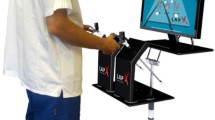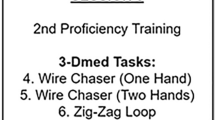Abstract
Background
Surgeons’ personalities have been described as different from those of the general population, but this was based on small descriptive studies limited by the choice of evaluation instrument. Furthermore, although the importance of the human factor in team performance has been recognized, the effect of personality traits on technical performance is unknown. This study aimed to compare surgical residents’ personality traits with those of the general population and to evaluate whether an association exists between their personality traits and technical performance using a virtual reality (VR) laparoscopy simulator.
Methods
In this study, 95 participants (54 residents with basic, 29 with intermediate laparoscopic experience, and 12 students) underwent personality assessment using the NEO-Five Factor Inventory and performed five VR tasks of the Lap Mentor™ basic tasks module. The residents’ personality traits were compared with those of the general population, and the association between VR performance and personality traits was investigated.
Results
Surgical residents showed personality traits different from those of the general population, demonstrating lower neuroticism, higher extraversion and conscientiousness, and male residents showed greater openness. In the multivariable analysis, adjusted for gender and surgical experience, none of the personality traits was found to be an independent predictor of technical performance.
Conclusions
Surgical residents present distinct personality traits that differ from those of the general population. These traits were not found to be associated with technical performance in a virtual environment. The traits may, however, play an important role in team performance, which in turn is highly relevant for optimal surgical performance.



Similar content being viewed by others
References
Seymour NE, Gallagher AG, Roman SA, O’Brien MK, Bansal VK, Andersen DK, Satava RM (2002) Virtual reality training improves operating room performance. Ann Surg 236:458–464
Grantcharov TP, Kristiansen VB, Bendix J, Bardram L, Rosenberg J, Funch-Jensen P (2004) Randomized clinical trial of virtual reality simulation for laparoscopic skills training. Br J Surg 91(146–150):23
Andreatta PB, Woodrum DT, Birkmeyer JD, Yellamanchilli RK, Doherty GM, Gauger PG, Minter RM (2006) Laparoscopic skills are improved with LapMentor™ training: results of a randomized, double-blinded study. Ann Surg 243:854–863
McDougall EM, Corica FA, Boker JR, Sala LG, Stoliar G, Borin JF, Chu FT, Clayman RV (2006) Construct validity testing of a laparoscopic surgical simulator. J Am Coll Surg 202:779–787
Yamaguchi S, Konishi K, Yasunaga T, Yoshida D, Kinjo N, Kobayashi K, Ieiri S, Okazaki K, Nakashima H, Tanoue K, Maehara Y, Hashizume M (2007) Construct validity for eye–hand coordination skill on a virtual reality laparoscopic surgical simulator. Surg Endosc 21:2253–2257
Gawande AA, Zinner MJ, Studdert DM, Brennan TA (2003) Analysis of errors reported by surgeons at three teaching hospitals. Surgery 133:614–621
Yule S, Flin R, Paterson-Brown S, Maran N (2006) Nontechnical skills for surgeons in the operating room: a review of the literature. Surgery 139:140–149
Yule S, Flin R, Maran N, Rowley D, Youngson G, Paterson-Brown S (2008) Surgeons’ nontechnical skills in the operating room: reliability testing of the NOTSS behavior rating system. World J Surg 32:548–556
Thomas JH (1997) The surgical personality: fact or fiction. Am J Surg 174:573–577
Bradley JH, Hebert FJ (1997) The effect of personality type on team performance. J Manag Dev 16:337–353
Bruhn JG, Parsons OA (1964) Medical student attitudes toward four medical specialties. J Med Educ 39:40–49
Schwartz RW, Barclay JR, Harrell PL, Murphy AE, Jarecky RK, Donnelly MB (1994) Defining the surgical personality: a preliminary study. Surgery 115:62–68
McGreevy J, Wiebe D (2002) A preliminary measurement of the surgical personality. Am J Surg 184:121–125
Borkenau P, Ostendorf F (2008) NEO-fünf-faktoren-inventar nach costa und mccrae (manual). Hogrefe, Göttingen
R Development Core Team (2011) R: a language and environment for statistical computing. R Foundation for Statistical Computing, Vienna. ISBN 3-900051-07-0. http://www.R-project.org. Accessed 21 June 2011
Callister JD, King RE, Retzlaff PD, Marsh RW (1999) Revised NEO personality inventory profiles of male and female US Air Force pilots. Mil Med 164:885–890
McCulloch P, Kaul A, Wagstaff GF, Wheatcroft J (2005) Tolerance of uncertainty, extroversion, neuroticism, and attitudes to randomized controlled trials among surgeons and physicians. Br J Surg 92:1293–1297
Warschkow R, Steffen T, Spillmann M, Kolb W, Lange J, Tarantino I (2010) A comparative cross-sectional study of personality traits in internists and surgeons. Surgery 148:901–907
Swanson JA, Antonoff MB, D’Cunha J, Maddaus MA (2010) Personality profiling of the modern surgical trainee: insights into generation X. J Surg Educ 67:417–420
Kennedy MM (2002) Managing change: understanding the demographics of the evolving workforce. Proc Annu Conv AAEP 48:467–470
Foster KN, Neidert GP, Brubaker-Rimmer R, Artalejo D, Caruso DM (2010) A psychological profile of surgeons and surgical residents. J Surg Educ 67:359–470
Merlo LJ, Matveevskii AS (2009) Personality testing may improve resident selection in anesthesiology programs. Med Teach 31:e551–e554
Cadeddu JA, Kondraske GV (2007) Human performance testing and simulators. J Endourol 21:300–304
Wanzel KR, Hamstra SJ, Caminiti MF, Anastakis DJ, Grober ED, Reznick RK (2003) Visual-spatial ability correlates with efficiency of hand motion and successful surgical performance. Surgery 134:750–757
Rosenthal R, Hamel C, Oertli D, Demartines N, Gantert WA (2010) Performance on a virtual reality angled laparoscope task correlates with spatial ability of trainees. Indian J Surg 72:327–330
Fletcher GC, McGeorge P, Flin RH, Glavin RJ, Maran NJ (2002) The role of nontechnical skills in anaesthesia: a review of current literature. Br J Anaesth 88:418–429
Reason J (2000) Human error: models and management. BMJ 320:768–770
Rosenthal R, Gisin S, Gantert W, Ummenhofer W, Zobrist R, Oertli D, Scheidegger D (2006) ACMS—advanced complication management simulation. Swiss Knife 1:15–16
Crossley J, Marriott J, Purdie H, Beard JD (2011) Prospective observational study to evaluate NOTSS (nontechnical skills for surgeons) for assessing trainees’ nontechnical performance in the operating theatre. Br J Surg 98:1010–1020
Morgeson FP, Campion MA, Dipboye RL, Hollenbeck JR, Murphy K, Schmitt N (2007) Are we getting fooled again? Coming to terms with limitations in the use of personality tests for personnel selection. Pers Psychol 60:1029–1049
McCrae RR, Costa PT Jr (2004) A contemplated revision of the NEO five-factor inventory personality and individual differences 36:587–596
Acknowledgments
The authors’ acknowledge all the study participants, the board of directors, and the faculty at the 29th International Gastrointestinal Surgery Workshop held at Davos 2011 for supporting our study. This study was supported by Swiss National Science Foundation grant 3200B0-120722/1. The Basel Institute for Clinical Epidemiology and Biostatistics is supported by grants from Santésuisse and from the Gottfried and Julia Bangerter–Rhyner Foundation. The funding source had no role in the design or performance of the study; the collection, management, analysis, or interpretation of the data; or the preparation, review, or approval of the manuscript.
Disclosures
Rachel Rosenthal, Juliane Schäfer, Henry Hoffmann, Martina Vitz, Daniel Oertli, and Dieter Hahnloser have no conflicts of interest or financial ties to disclose.
Author information
Authors and Affiliations
Corresponding author
Rights and permissions
About this article
Cite this article
Rosenthal, R., Schäfer, J., Hoffmann, H. et al. Personality traits and virtual reality performance. Surg Endosc 27, 222–230 (2013). https://doi.org/10.1007/s00464-012-2424-z
Received:
Accepted:
Published:
Issue Date:
DOI: https://doi.org/10.1007/s00464-012-2424-z




